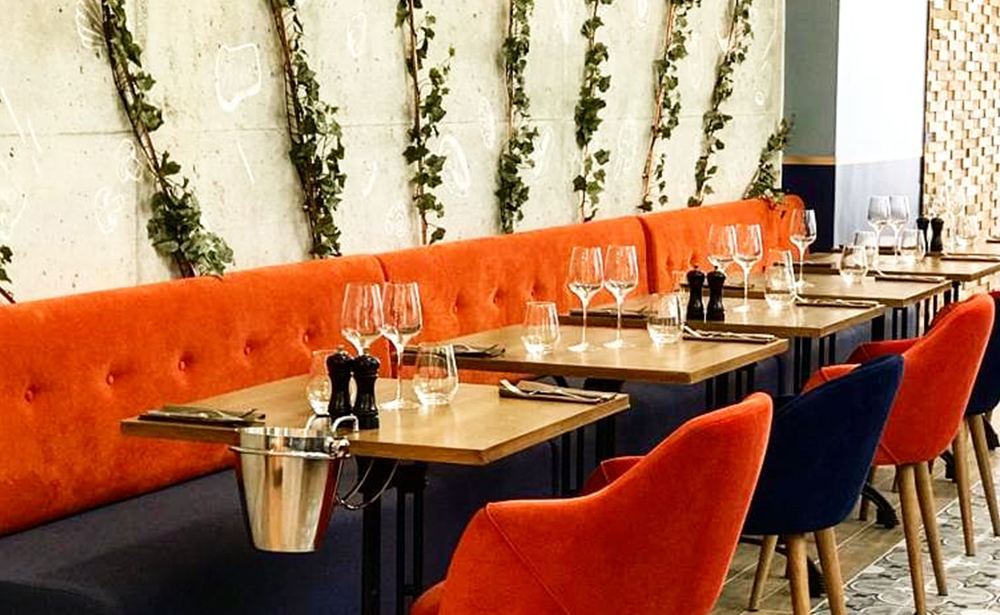
The restaurant industry is a fast-paced, vibrant and exciting place to build a business and, unsurprisingly, opening a restaurant is the ambitious dream of foodies and entrepreneurs alike.
With the Australian restaurant industry currently worth $18.5 billion and a projected growth forecast of 5.1% in 2021, opening a restaurant can be a very profitable venture. However, a competitive market along with high operating costs and razor-thin margins means aspiring restaurant owners need a meticulous plan if they want to start and grow a successful restaurant business.
To help, we’ve created the ultimate guide for aspiring restaurant owners to empower you to take the first steps towards opening your very own restaurant.
- Concept and business plan
- Cost of opening a restaurant and funding
- Location and venue
- Licences, certificates and insurance
- Menu
- Restaurant equipment
- Restaurant technology
- Restaurant recruitment
- Marketing
- Opening day
1. Concept and business plan
Your restaurant’s concept and business plan will provide the foundation for your business and shape your day-to-day operations. Without a clear concept or business plan, it will be difficult to keep your overall goals and objectives in sight. However, if you take the time to outline each of these, it will be much easier to make informed decisions and determine what your projected start-up costs will be.
Concept
With such fierce competition in the market, you’ll need to create an enticing concept that offers your guests a unique experience to stand out from the crowd.
There are so many varieties of restaurants, each with its own unique theme, food offering and service style that it’s crucial to find an angle that no one else is using to set your restaurant apart from the competition.
What will entice people through your doors, how will customers remember you and what will make them come back for more? Will you only use local ingredients or offer wine pairings with each course, for example. Do you envision a lively burger joint, laid-back pizza restaurant, cosy pub or upmarket seafood restaurant? It’s also important to think about your ideal customer – who are they and what are their values and interests?
Taking the time to map out your concept and outline your target customer will enable you to perfectly tailor everything from your menu to your music, marketing strategy and service style.
Restaurant business plan
A detailed business plan is the key to your restaurants’ success and outlines your vision by detailing how your business will take shape and operate.
Your restaurant business plan should include:
- Executive summary
- Company overview
- Market analysis
- Marketing plan
- Operations plan
- Financial analysis
One of the major benefits of writing a restaurant business plan is that it will enable you to outline any potential challenges that you might face in the run-up to opening your restaurant. Understanding these hurdles before they occur allows you to adequately prepare, and build any potential costs into your budget.
Free restaurant business plan template
This easy-to-use business plan template is designed to help aspiring restaurant owners set their plans into motion.
2. Cost of opening a restaurant and funding
It’s estimated that the average restaurant owner in Australia spends $650,000 establishing their restaurant. While each restaurant is different, you should expect to budget for the following things before you can open your doors:
- Business Lease
- Refurbishment costs
- License Fees
- Insurance
- Furniture and equipment
- Lighting and plumbing
Tip: use this free government resource to help calculate the startup costs of your business.
Opening a restaurant requires a considerable upfront investment, and it can be difficult to raise the capital needed to launch your business. There are, however, a couple of options to help first-time business owners with their finances.
Government grants
The federal and state governments regularly create financial assistance packages and initiatives to help new businesses get up and running. Current assistance initiatives include:
- Instant asset write-offs
- Equipment rebates
- Aboriginal business development funding
- New business advice and mentoring
- Assistance for hiring apprentices or unemployed workers
- Subsidies for installing energy-efficient lighting
There are hundreds of government grants available, with new initiatives launched throughout the year, so it’s essential to keep up to date with the most recent support available for your restaurant in your state or territory.
Bank loans
Bank loans are a popular funding source for first-time small business owners, and many banks offer a range of options. To understand which is the best option for your business, compare the following:
You can also check out the Australian Government’s business advice website to learn more about how to apply for a business loan.

3. Location and venue
The location of your venue is crucial to the ongoing success of your business, so it’s important to conduct thorough research into the neighbourhood and surrounding areas.
Location
Take the time to walk around your chosen area to understand what the local community is like – does your concept align with the type of people who work or live in the neighbourhood and how often does your target demographic visit the area? It’s also important to assess the amount of foot traffic, public transport links and parking (or lack of) as these factors will be instrumental in the success of your restaurant.
Tip: visit your chosen location at different times throughout the day to understand when the busiest and quietest times are. This will help you to decide if you should open for breakfast, lunch and dinner every day or if it will be more cost-effective to close during quiet times.
Venue: Leasing vs buying
Once you’ve decided on a suitable location for your restaurant, the next step is to secure a commercial space to bring your business to life. Typically, there are two main options to consider: leasing a venue or buying an existing establishment.
As commercial leases are usually long term you’ll need to commit to a minimum 5-year lease and should budget for the following:
- 1 to 3 months rent for a refundable deposit.
- Six months rent to ensure you’re covered financially while your restaurant becomes established.
Tip: Leasing a property will be the most significant expense for your new restaurant, and it’s recommended that rent be no more than 15% of your projected yearly income.
If you’d prefer to buy your commercial space, look for a venue that’s already been converted for commercial purposes. This will save time and money in the long run, as many of the costly aspects of setting up a restaurant, like installing toilets and running water, will have already been accounted for.
Renovations and decor
Once you’ve secured a space for your restaurant, it will likely need renovations to create the aesthetic you’re looking for. If you’ve invested in an existing food service business then a cosmetic upgrade might be enough to bring your venue to life.
On the other hand, your new venue might need a complete overhaul. This could include structural renovations, installing a kitchen and toilets and interior design work.
To avoid investing in a property that requires significant renovations, and to keep costs low, keep the following points in mind when you’re looking for a venue:
- How much space will you devote to dining, bar, kitchen, bathrooms and storage?
- How will customers, staff, food and drinks move through the venue?
- What is the capacity of the venue and how many tables, chairs, or booths can you fit in the space?
- Is the kitchen space adequate for your production needs and does it create the best flow for receiving stock, storage, prep, cooking, plating and dishwashing?
- Is there enough space for the equipment you’ll need?

4. Licences, certificates and insurance
Before you can open your doors to the public you’ll need several licences and certificates to legally operate. The exact licences and certificates you’ll need will vary depending on your venue size, state government and concept. The application process is often lengthy and costly, so it’s crucial to get a head start on applications early on in the process.
In most cases, new restaurants will need the following:
- Business licence – you’ll need to obtain a business license by registering your restaurant with the local council. Please visit the Australian Business License and Information Service website for more information.
- Council certificates – you’ll need to apply to your local council for several certificates, including, zoning, fire safety, occupation and compliance certificates.
- Liquor license – any venue that sells alcohol will need to obtain a liquor license from the appropriate state or territory government. However, the type of license you’ll need will depend on your business operations.
- Food license – you’ll need a food licence to legally sell food in your restaurant. Licencing requirements vary by state and the size of your venue. Visit your local state government website for more information.
- Music licence – if you plan to play music in your restaurant, you’ll need a music licence to cover copyright issues.
- Insurance – you should invest in several insurance policies to ensure your business is covered if anything goes wrong. Consider public liability insurance, product liability insurance, property insurance, workers compensation insurance and theft insurance as a starting point.
Remember: depending on your operational requirements, you may need several other licences and certificates, so it’s essential to consult with your local council before opening.
5. Menu
Your menu will be the key to your restaurant’s success and it should ignite excitement in your guests and keep them coming back, time and again. However, it’s important to do your research before finalising your menu to ensure your dishes will appeal to your target customers and that you’re also filling a gap in the market.
To craft the perfect menu, each of the following elements will need careful consideration.
Concept
Take the time to outline your menu’s concept with your chefs and bar manager. How extensive will your food offering be? Will you change your menu with the seasons and focus on locally sourced ingredients? What about your drinks? Will you offer wine pairings with certain dishes, an aperitivo or coffee to finish?
Design
Menu design needs careful consideration. An effective menu maintains focus, reduces decision time for guests and, most importantly, drives sales.
Prices
Take the time to research different menu pricing strategies to ensure your price point aligns with your target demographic’s budget and competitors’ pricing. Your pricing strategy is integral to the success of your menu, and it’s important to find the right balance between appealing prices for your customers and healthy margins for your bottom line.

6. Restaurant equipment
Equipment costs can vary enormously, so it’s essential to understand your operational requirements before investing in equipment. As a starting point, consider the following to execute your menu, store inventory, wash crockery and cutlery and keep your venue clean.
- Kitchen equipment, e.g. ovens, fridges, toasters, microwaves.
- Bar equipment, e.g. cocktail shakers, spirit measures, blenders.
- Workspaces, e.g. preparation tables, countertops.
- Service equipment, e.g. trays, glassware, crockery, utensils, takeaway containers.
- Storage, e.g. shelving, display cabinets, containers.
- Inventory, e.g. vegetables, meat, dairy, wine, beer.
7. Restaurant technology
To operate efficiently and streamline day-to-day operations new restaurants will need to invest in several pieces of technology.
Restaurant POS system
Your restaurant POS system will be the centre of your business for years to come and will efficiently manage everything from ordering to payments and reporting. Therefore, it’s essential to pick a system that aligns with your business goals and can scale with your business as it grows.
Use the following criteria to understand what features your POS will need.
Ordering – your POS system should facilitate several different ordering options, including; QR table ordering, order at the counter, table service, delivery and collection.
Payments – your POS should make it easy to split bills, run tabs, accept various payment methods and collect payment at the table.
Inventory – the right POS should manage and track your inventory so you never over or under order, saving you time and money.
Reporting – ensure your chosen POS has a detailed reporting tool. These insights will let you know what you’re doing right and what needs to change, which menu items perform best, which employees sell the most and more.
Accounting – ensure your chosen accounting package integrates with your POS for automatic reconciliation and efficient revenue and expense tracking.
As well as a POS system, there are several pieces of hardware and software that restaurants can use to automate processes and collect data to optimise their business.
Hardware
- iPads for your point of sale system
- Receipt printer
- Kitchen/ bar printer
- Cash drawer
- Payment terminal
Software
- POS platform
- Marketing software
- Employee management
- Delivery and collection services
- Accounting software
Tip: budget at least $1,00 for new hardware and a minimum of $100 per month for software subscriptions.
8. Restaurant recruitment
Your team will play a big part in your restaurant’s success, so it’s crucial to invest time in finding the right people before you open your doors.
Don’t rush the recruitment process. Take the time to find the best people who share your passion and will help make your business thrive.
Training
A thorough training program will set your new staff up for success in their role. While training can be a time-consuming process, it’s worth investing in. A first-class training program not only provides staff with the skills they need to perform their duties, but it will also make them feel valued so they’re more likely to take pride in their work and want to stay working for you.
9. Marketing
Marketing is an integral part of cultivating a successful business. With the majority of consumers checking out a business online before deciding to visit, it’s important to ensure your restaurant is easily accessible and visible on as many digital platforms as possible.
Consider the following marketing platforms and initiatives to drive awareness for your new restaurant.
- Restaurant website – your restaurant website will be the first interaction many customers will have with your business – it’s where they look when they want to make a reservation, check out your menu, or find out where you’re located. So make it easy for them.
- Social media – dedicate time to nurturing a community of followers on both Instagram and Facebook. In the month before you open, set time aside to regularly post and showcase your offering to reach new customers.
- Directories and review sites – set up profile sites like TripAdvisor and Yelp to make it easy for potential customers to find out about your restaurant.
- Google My Business – set up a Google My Business account to ensure your restaurant appears at the top whenever someone searches for your business.
- Events and special offers – entice people through your doors with events and special e.g. meal deals, buy-one-get-one-free offers, happy hours, live music, charity events etc.
Tip: social media advertising is also a great way to boost awareness in your local area. Before opening your doors, consider investing in social media adverts to promote your restaurant to your target demographic and drum up excitement.
10. Opening day
You’ve signed the lease, purchased the equipment, hired a team and nailed down your marketing plan – it’s nearly time to open your restaurant and welcome people through your doors.
Soft opening
Before opening your doors to the public, host a soft opening to test run your menu, workflows and service to iron out any issues. Invite your friends, family, local business owners and suppliers as they’re likely to be more forgiving if mistakes are made.
Your soft opening is also the first time your team will get to work together (aside from training), so be prepared to give feedback if necessary.
Grand opening
Your grand opening is the first time you’ll welcome the public through your doors and marks the final step in your journey to opening a restaurant.
Drum up excitement before the big day on your website and social media to encourage people to come and try you out. And don’t worry if mistakes happen. It’s very rare for a restaurant to open without at least one error being made.
Opening a restaurant: turn your dream into reality
Opening a restaurant is an exciting, albeit nerve-wracking process and you’ll need a serious amount of grit and determination to make it past the finish line
No matter if you’re opening a lively burger joint or upmarket bistro you’ll need to dedicate a lot of time and energy to turn your dream into a reality. We hope this guide inspires you to take the first steps to start your own restaurant and empowers you to make the right decisions to build a successful business.
Free restaurant business plan template
This easy-to-use business plan template is designed to help aspiring restaurant owners set their plans into motion.

News you care about. Tips you can use.
Everything your business needs to grow, delivered straight to your inbox.

